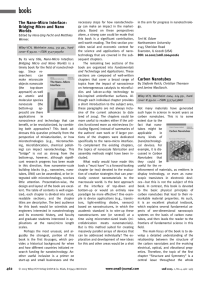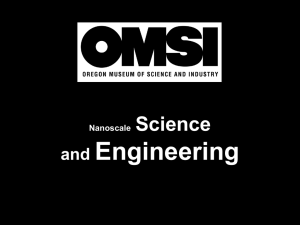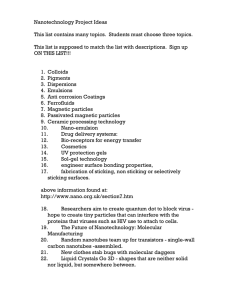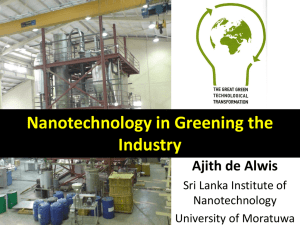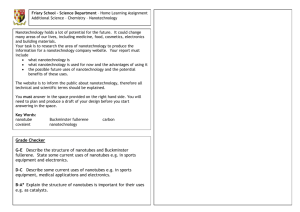WHAT IS NANO TECHNOLOGY? - Yaşar Üniversitesi | Journal
advertisement
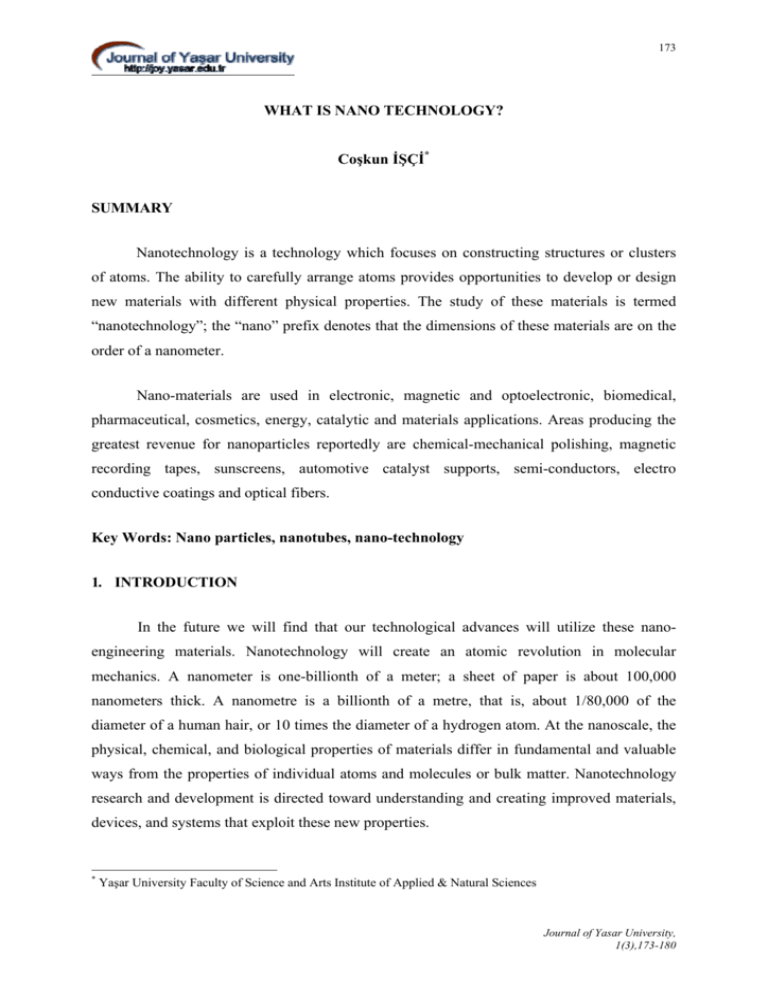
173 WHAT IS NANO TECHNOLOGY? Coşkun İŞÇİ* SUMMARY Nanotechnology is a technology which focuses on constructing structures or clusters of atoms. The ability to carefully arrange atoms provides opportunities to develop or design new materials with different physical properties. The study of these materials is termed “nanotechnology”; the “nano” prefix denotes that the dimensions of these materials are on the order of a nanometer. Nano-materials are used in electronic, magnetic and optoelectronic, biomedical, pharmaceutical, cosmetics, energy, catalytic and materials applications. Areas producing the greatest revenue for nanoparticles reportedly are chemical-mechanical polishing, magnetic recording tapes, sunscreens, automotive catalyst supports, semi-conductors, electro conductive coatings and optical fibers. Key Words: Nano particles, nanotubes, nano-technology 1. INTRODUCTION In the future we will find that our technological advances will utilize these nanoengineering materials. Nanotechnology will create an atomic revolution in molecular mechanics. A nanometer is one-billionth of a meter; a sheet of paper is about 100,000 nanometers thick. A nanometre is a billionth of a metre, that is, about 1/80,000 of the diameter of a human hair, or 10 times the diameter of a hydrogen atom. At the nanoscale, the physical, chemical, and biological properties of materials differ in fundamental and valuable ways from the properties of individual atoms and molecules or bulk matter. Nanotechnology research and development is directed toward understanding and creating improved materials, devices, and systems that exploit these new properties. * Yaşar University Faculty of Science and Arts Institute of Applied & Natural Sciences Journal of Yasar University, 1(3),173-180 TEKNOLOJİ BAĞIMLI YAŞAMIN MATEMATİKSEL DESENLERİ-I 174 2. NANOTUBES Graphite is probably the strongest material made from atoms and electrons. Sheets of material are definitely unstable. If the atoms are e-longed , it becomes a nanotube.For example, a new form of carbon, - the nanotube-was discovered by Sumio Iijima in 1991. In 1995, it was recognized that carbon nanotubes were excellent sources of field-emitted electrons. By 2000, the “jumbotron lamp,” a nanotube-based light source that uses these fieldemitted electrons to bombard a phosphor, was available as a commercial product. (Jumbotron lamps light many athletic stadiums today). The discovery of another nanoscale carbon form, C60, the fullerene (also called the buckyball) brought the Nobel Prize in Chemistry in 1996 to Robert F. Curl Jr., Sir Harold W. Kroto, and Richard E. Smalley. It also started an avalanche of research into not only the novel characteristics of C60, but also other nanoscale materials. Carbon nanotubes, long, thin cylinders of carbon. These are large macromolecules that are unique for their size, shape, and remarkable physical properties. They can be thought of as a sheet of graphite (a hexagonal lattice of carbon) rolled into a cylinder. These intriguing structures have sparked much excitement in the recent years and a large amount of research has been dedicated to their understanding. Currently, the physical properties are still being discovered and disputed. What makes it so difficult is that nanotubes have a very broad range (a) (b) (c) of electronic, thermal, and structural properties that change depending on the different kinds of nanotube (defined by its diameter, length, and twist). İşçi, 2006 175 Figure.1. Carbon Nonotube; (a) Flat sheet of Graphite , (b) Partially rolled sheet of graphite, (c) and (d) carbon nanotubes Carbon nanotube (CNT) is a new form of carbon, configurationally equivalent to two dimensional graphite sheet rolled into a tube. It is grown now by several techniques in the laboratory and is just a few nanometers in diameter and several microns long. Figure.2. Carbon Nonotube as a semiconductor device CNT can be metallic or semiconducting and offers amazing possibilities to create future nanoelectronics devices, circuits, and computers. Figure.3. Carbon Nonotube as a very stiff Material Carbon nano tubes exhibits extraordinary mechanical properties: the Young's modulus is over 1012 Pascal ( tera-pascal). It is stiff as diamond. The estimated tensile strength is 200 Giga Pascal. These properties are ideal for reinforced composites, nano electromechanical systems Journal of Yasar University, 1(3),173-180 TEKNOLOJİ BAĞIMLI YAŞAMIN MATEMATİKSEL DESENLERİ-I 176 Figure.4. Carbon Fullerenes 3. APPLICATIONS OF NANO-MATERIALS 3.1. Medical & biological applications One area of nanotechnology R&D is medicine. Medical researchers work at the microand nano-scales to develop new drug delivery methods, therapeutics and pharmaceuticals. For a bit of perspective, the diameter of DNA, our genetic material, is in the 2.5 nanometer range, while red blood cells are approximately 2.5 micrometers. Additional information about nanoscale research in medicine is available from the National Institutes of Health. One of the most innovative new products is one that enhances biological imaging for medical diagnostics and drug discovery. Quantum dots are semi-conducting nanocrystals that, when illuminated with ultraviolet light, emit a vast spectrum of bright colors that can be used to identify and locate cells and other biological activities. These crystals offer optical detection up to a thousand times brighter than conventional dyes used in many biological tests. The pharmaceutical and chemical industries are being impacted greatly by nanotechnology. New commercial applications of nanotechnology that are expected in two to five years in these and other industries include: Advanced drug delivery systems, including implantable devices that automatically administer drugs and sensor drug levels. İşçi, 2006 177 Use of electronic and magnetic devices in, for example, Magnetic Resonance (MR) to diagnosis patients’ knee problem to apply arthroscopic operation which helps the patient to recover in a week provides great advantage to the person. 3.2. Magnetic storage devices Today most computer hard drives contain giant magnetoresistance (GMR) heads that, through nano-thin layers of magnetic materials, allow for an order of magnitude increase in storage capacity. Other electronic applications include non-volatile magnetic memory, automotive sensors, landmine detectors and solid-state compasses. Figure.5. Nanodots 150nm circular magnetic dots, 5nm thick, made by Focused Ion Beam milling (Durham University. Nano-technology Lab) 3.3. Applications in industry Nanomaterials, which can be purchased in dry powder form or in liquid dispersions, often are combined with other materials today to improve product functionality. Some applications can be listed as follows; Bumpers on cars, paints and coatings to protect against corrosion, scratches and radiation, protective and glare-reducing coatings for eyeglasses and cars, metal-cutting tools, sunscreens and cosmetics, longer-lasting tennis balls, light-weight, stronger tennis racquets, stain-free clothing and mattresses, dental-bonding agent, burn and wound dressings, ink, automobile catalytic converters . Cooling chips or wafers to replace compressors in cars, refrigerators, air conditioners and multiple other devices, utilizing no chemicals or moving parts; photovoltaics (solar cells), fuel cells and portable power to provide inexpensive, clean energy can be made by nanomaterials. Journal of Yasar University, 1(3),173-180 TEKNOLOJİ BAĞIMLI YAŞAMIN MATEMATİKSEL DESENLERİ-I 178 3.4. Polymers and some special materials With basic research under way for 20-plus years, nanotechnologies are gaining in commercial introductions. In the short term, nanoparticles will be introduced into many existing materials, making them stronger or changing their conductive properties. Significantly stronger polymers will make plastics more widely used to reinforce materials and replace metals, even in the semi-conductor area. The latest display technology for laptops, cell phones, digital cameras and other uses are made of nanostructured polymer films. Known as OLEDs, or organic light emitting diodes, several large companies will begin producing them in late 2003 and early 2004. Among OLED screen advantages are brighter images, lighter weight, less power consumption and wider viewing angles. The oil industry relies on nanoscale catalysts for refining petroleum, while the automobile industry is saving large sums of money by using nanosized – in place of larger – platinum particles in its catalytic converters. Because of their size, filters made of nanoparticles also have been found to be excellent for liquid filtration. Several products are now available for large-scale water purification that can take out the tiniest bacteria and viruses from water systems, in addition to chemicals and particulate matter.Another example of rapid insertion of nanotechnology into useful applications is in the field of wear-resistant coatings. In the mid-1990s nanoceramic coatings exhibiting much higher toughness than conventional coatings were first developed. In 2000, the first nanostructured coating was qualified for use on gears of air-conditioning units for U.S. Navy ships. 4.CONCLUSION Nanotechnology, nowadays most discussed subject is applicable in different areas in business. Its use in for example in paint and coating industry provides strategic competitive advantage to pioneering firms. It is essential for the scientists and engineers to know about and understand economic issues simply because the company for he or she works must realize a profit from the products it manufactures. The quality of life for this and future generation will depend, to some degree, on how these issues are addressed by the engineering community. İşçi, 2006 179 In spite of the tremendous progress that has been made in the materials science and engineering within past a few years, there still remain technological challenges, including the development of even more sophisticated and specialized materials. Journal of Yasar University, 1(3),173-180 TEKNOLOJİ BAĞIMLI YAŞAMIN MATEMATİKSEL DESENLERİ-I 180 REFERENCES 1. William, D.C.(2003), Materials Science and Engineering , John Wiley &Sons, Inc., 6th Edition. 2. Isci, C., Lecture Notes on Material Science, (2005) 3. http://www.nano.gov/html/facts/whatIsNano.html 4. Foster, L.E.(2005), Nanotechnology: Science, Innovation and Opportunity, Prentice Hall 5. Addison, M.(2004) , Smart Materials and Technologies in Architecture, Architectural Press 6. http://nanotube.msu.edu 7. http://www.nano.org.uk 8.. Lijima, S. (1991)"Helical microtubules of graphitic carbon", Nature 354, 56 İşçi, 2006

